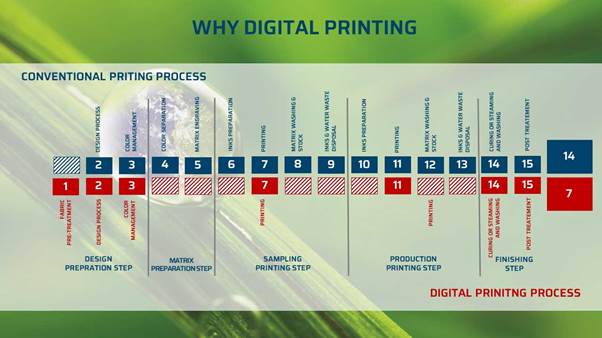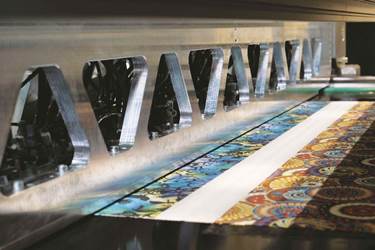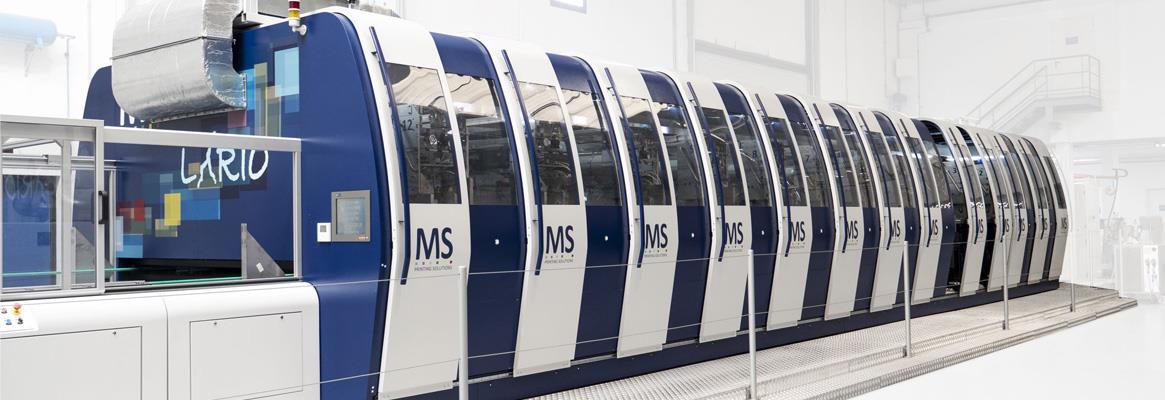Sustainability is a matter of actions, not of words. And digital textile printing is the answer.
This is what we think; and drives our day-to-day actions in helping the textile printing companies to implement a sustainable production chain. Thus, in 2011 – anticipating the times – we designed the Lario Single-pass digital printing machine, which today is even more relevant than ever before, to reduce chemical waste, CO2 emissions, and water consumption.
The pandemic has marked a turning point in the textile printing industry.
Since 2020, the pandemic and market turbulence have radically changed the textile market. One of the main effects of these events is the speed-up of the customers’ migration from physical retail to online shopping, which implies an increasing pressure on the global supply chain, due to the shorter time to market. Digital printing technology combined with a partial reshoring of production is the way to deal with the ongoing increase of logistics and process costs and prevent new supply chain disruption in future crises, choosing a sustainable high quality performing technology.
Fast, versatile, and sustainable, digital printing right fits the production needs of our time.
Single-pass technology revives – in a modern twist – the conventional textile printing: print heads remain stationary while the fabric runs underneath by a rotating belt. It provides reliability and productivity close to the conventional ones so much that, today, 32 MS Lario printing machines are working worldwide with a printing production speed up to 75 m/min.
The online-shopping demand stands out for less re-order predictability and the collections’ high customisation. The single-pass tech perfectly fits these requests, even if printing runs decline has reduced the gap in production capacity compared to the last generation scanning machines.
The Lario single pass makes the most out of printing heads’ performance, offering high and constant productivity over time. This result has been possible thanks to the advancements in the development of print heads – last generation ones – and inks and the designing of customised inks and waveforms, thanks to the cooperation between MS and JK R&D teams.
The Maintenance of A Single-Pass Printing Machine Is As Simple As It Seems
It is comparable to the last generation of digital scanning machines. A cleaning environment and regular maintenance assure the long life of printheads, electronic components, and the machine itself. Moreover, we have conceived a multiple service set, that helps to control costs and simplify the activities of the users, optimising performance and return of investments. And of course, we have the same attention and recommendations for the inks through the JK Group service engineers. The multiple service set ensures the best production efficiency, maximising profits.
 There are lot of reasons for preferring digital textile printing.
There are lot of reasons for preferring digital textile printing.
It is a faster, eco-friendly, and less costly process, without forgetting that the space to configure a digital printing department is around three times less than the one for a rotary or flat bad printing department.
This is possible thanks to the shorter process: 7 working steps instead of the 14 (see diagram above) required by the conventional printing process. It is fundamental to consider facts when making decisions in this regard. We want to point out six good reasons for choosing digital textile printing technology:
1. The water consumption is 60 per cent less, and the energy consumption is 30 per cent less compared to the standard rotary textile printing process.
2. The Process Carbon footprint is nearly 40 per cent less (see the Green Label by ACIMIT)
3. The inks wastage is 20 per cent less because colour management is through software, thus using only the ink quantity necessary to achieve colours and designs.
4. The fabric wastage during the design/colourways change is nearly null. Thus, expanding the designers’ creativity at low costs as well as granting a lean workflow.
5. Digital printing allows the potential production of infinity colourways and designs.
6. Generally speaking, and for those who already are working in textile printing industry, the process of shifting from conventional printing to digital one is a matter of training. At MS’ Academy, we have set different training levels aimed at supporting our customers in this change.

Consumers are ever more mindful of sustainable and responsible purchases, thus to the entire production chain. Digital textile printing offers the way to realise the sustainable production demanded by consumers worldwide, such as responding to supply and production chains’ big challenges, binding for the textile industry.
We desire to return 10L of water to every human being. This is possible by replacing the traditional cylinder machines with 300 Lario single-pass. Together we will work to achieve even greater success.










Comments